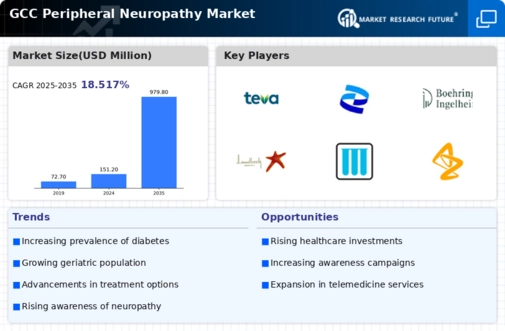The GCC Peripheral Neuropathy Market has emerged as a significant sector within the healthcare landscape, driven by rising incidences of neurological disorders and an increasing emphasis on patient-centric therapies.
This market involves various treatment modalities, including pharmacological interventions, physical therapy, and advances in medical technology aimed at alleviating symptoms caused by peripheral neuropathy.
Several key players are actively engaged in this market, each striving to capture market share through innovative product offerings, strategic partnerships, and geographical expansions within the Gulf Cooperation Council region.
The focus on enhancing patient outcomes and developing more effective therapies highlights the competitive dynamics at play, as companies aim to differentiate themselves through research and development efforts, collaboration with healthcare providers, and adapting to regulatory frameworks specific to the GCC markets.
Teva Pharmaceuticals has established a notable presence in the GCC Peripheral Neuropathy Market, leveraging its strengths in generic and specialty pharmaceuticals. The company's robust portfolio includes a range of medications aimed at managing pain associated with peripheral neuropathy, which allows it to cater effectively to diverse patient needs.
Teva's established distribution networks and a strong understanding of regional healthcare regulations enable the company to maintain a competitive edge. Moreover, by investing in localized manufacturing and tapping into regional research capabilities, Teva Pharmaceuticals continues to strengthen its footing within the GCC, ensuring a sustainable supply of its essential therapeutic options.
Implementing tailored marketing strategies focused on the unique aspects of GCC demographics further enhances its visibility among healthcare professionals and patients alike.
Pfizer, renowned for its extensive research and development capabilities, has made significant inroads into the GCC Peripheral Neuropathy Market with a focus on advanced therapeutics and patient access programs.
The company's key products targeting neuropathic pain highlight its commitment to transforming treatment paradigms in the region. With a strong emphasis on innovation and patient-centric approaches, Pfizer continuously engages in partnerships that enhance its research capabilities and expand its therapeutic offerings.
Its market presence is reinforced through strategic mergers and acquisitions that bolster its portfolio, allowing for a comprehensive range of services tailored to meet the specific needs of patients suffering from peripheral neuropathy within the GCC.
The company's focus on education and support initiatives for healthcare providers plays a crucial role in establishing Pfizer as a leader in the region's neurological healthcare landscape, ensuring that it addresses the evolving needs of the population effectively.















